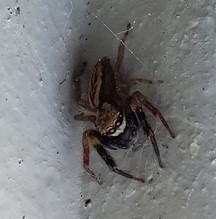Trite Auricoma on:
[Wikipedia]
[Google]
[Amazon]
''Trite auricoma'', commonly known as the golden-brown jumping spider, is a species of jumping spider

endemic
Endemism is the state of a species being found in a single defined geographic location, such as an island, state, nation, country or other defined zone; organisms that are indigenous to a place are not endemic to it if they are also found elsew ...
to New Zealand
New Zealand ( mi, Aotearoa ) is an island country in the southwestern Pacific Ocean. It consists of two main landmasses—the North Island () and the South Island ()—and over 700 smaller islands. It is the sixth-largest island count ...
.
__TOC__
Description
Adults are 8.4mm to 8.8mm in length. Thecephalothorax
The cephalothorax, also called prosoma in some groups, is a tagma of various arthropods, comprising the head and the thorax fused together, as distinct from the abdomen behind. (The terms ''prosoma'' and ''opisthosoma'' are equivalent to ''cepha ...
is coloured dark brown and is shaped rectangular and flattened. The abdomen tends to be patterned with grey-brown and orange colours. When fully mature, males have a yellow clypeal band that resembles a mustache. Females do not have this feature. Males also have a slimmer body and longer frontal legs.

Taxonomy
''Trite auricoma'' was first described by Arthur T. Urquhart in 1886 as ''Attus auricomus'' (Urquhart, 1886). Urquhart proceeded to unknowingly describe ''T. auricoma''synonyms
A synonym is a word, morpheme, or phrase that means exactly or nearly the same as another word, morpheme, or phrase in a given language. For example, in the English language, the words ''begin'', ''start'', ''commence'', and ''initiate'' are all ...
several times as ''Plexippus capillatus'', ''Attus suffuscus'', ''Attus kirkii'' and ''Attus adustus'' in 1890 and 1893, respectively. Independently, in 1917, Raymond Comte de Dalmas described another synonym, ''Trite vafra'', from samples he collected with Eugène Simon
Eugène Louis Simon (; 30 April 1848 – 17 November 1924) was a French naturalist who worked particularly on insects and spiders, but also on birds and plants. He is by far the most prolific spider taxonomist in history, describing over 4, ...
after visiting New Zealand from 1912 to 1913. In 1935, after examining type specimens from Canterbury Museum, Elizabeth Bangs Bryant
Elizabeth Bangs Bryant (April 7, 1875 – January 6, 1953) was an American arachnologist. She worked at the Museum of Comparative Zoology in Cambridge, Massachusetts and was a close acquaintance of James Henry Emerton.Deichmann, Elisabeth (195 ...
placed ''A. auricomus'' in the Trite genus and renamed the species as ''T. auricoma''. Bryant also recognized ''P. capillatus'', ''A. suffuscus'', ''A. kirkii'', ''A. adustus'' and ''T. vafra'' as synonyms of ''T. auricoma''.
Etymology
In Latin, the species name "auricoma" translates to "gold hair" ("auri" translates to gold, "coma" translates to hair). This is likely a reference to the gold-brown colour of the spider.Distribution and habitat
''Trite auricoma'' is widely distributed throughout New Zealand. ''T. auricoma'' can often be found in rolled up leaves of flax ('' Phormium'') or underneath dropped cabbage tree ('' Cordyline'') leaves. ''T. auricoma'' can also be found underneath stones, in vegetation and also on the ground.Diet
Like all spiders, ''Trite auricoma'' is an obligate carnivore. In experimental conditions, juvenile ''T. auricoma'' has been observed feeding on aphids and small flies such asDrosophila
''Drosophila'' () is a genus of flies, belonging to the family Drosophilidae, whose members are often called "small fruit flies" or (less frequently) pomace flies, vinegar flies, or wine flies, a reference to the characteristic of many species ...
. In experimental conditions, ''T. auricoma'' were more selective about prey choice, and fed on small flies and tachnids. ''T. auricoma'' also have to learn what is good to eat. It has been reported that juveniles will only eat slaters once, but then never again.
Behaviour
Hunting
Like most salticidae, ''Trite auricoma'' is a visual predator. If there is a fly within 15 cm of the front of the spider, the spider becomes alert. In the first stage, the legs and abdomen are shifted and straightened. The hind legs then become drawn in and the spider begins to slowly move towards the prey. Once the spider is 3–4 cm from its prey, it leaps and pierces the prey with its fangs. If a fly or other prey appears behind the spider, the spider will turn around and begin stalking. If the prey moves during stalking, the spider will turn its cephalothorax so that it is pointed at the prey. The abdomen will then also be moved into line with the cephalothorax and stalking will be resumed. If the prey begins to flee, then the spider will give chase and pounce. Hunger is thought to initiate hunting behaviour. Juvenile ''T. auricoma'' must learn to perfect the movements required in hunting. Juveniles usually miss their prey the first few times they hunt.Interactions with conspecifics
The spiderlings of ''T. auricoma'' do not react to each other while they are in the egg sac. However, once they have emerged, confrontations between juveniles result in one or both spiders raising their front legs. At this point, both spiders back away.Parasites
''Trite auricoma'' has been observed being parasitized by '' Priocnemis nitidiventris'', which paralyses the spider and feeds it to its young.References
{{Taxonbar, from=Q2251611 Salticidae Spiders of New Zealand Spiders described in 1886 Endemic fauna of New Zealand Endemic spiders of New Zealand